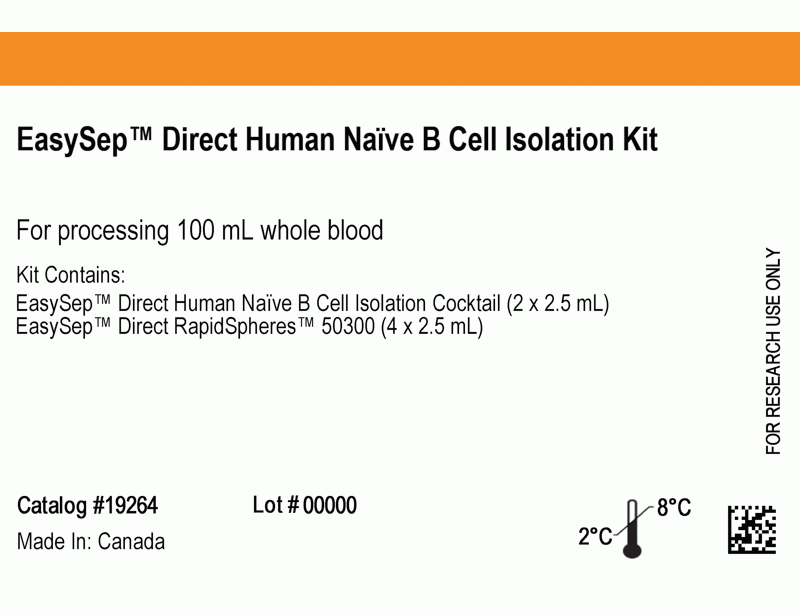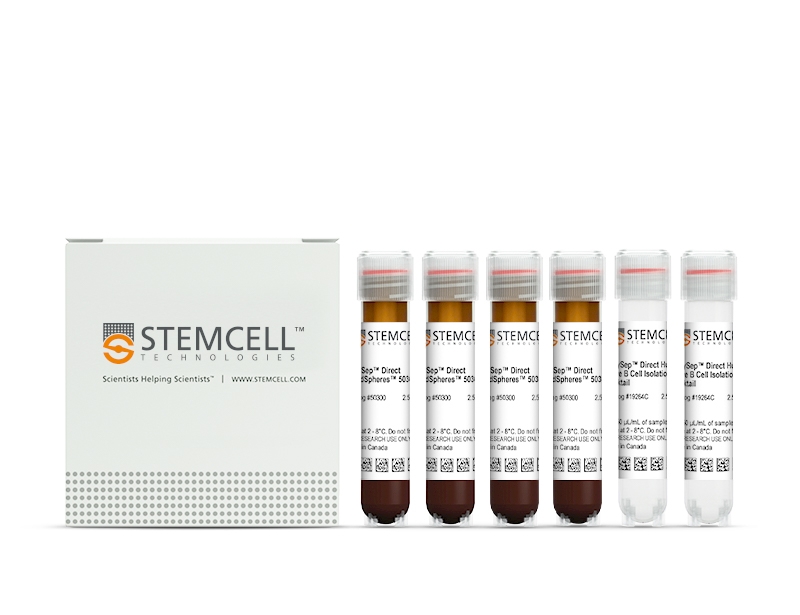EasySep™ Direct Human Naïve B Cell Isolation Kit
Immunomagnetic negative selection kit from whole blood
概要
This kit is used to isolate highly purified naïve B cells directly from human whole blood. Isolated cells are unlabeled with antibodies or particles and undergo minimal manipulation.
This kit targets non-naïve B cells for removal with antibodies recognizing specific surface markers. Unwanted cells are labeled with antibodies and EasySep™ Direct RapidSpheres™, and separated using an EasySep™ magnet. Desired cells are simply collected into a new tube and are immediately available for downstream applications such as flow cytometry, culture or DNA/RNA extraction.
This kit targets non-naïve B cells for removal with antibodies recognizing specific surface markers. Unwanted cells are labeled with antibodies and EasySep™ Direct RapidSpheres™, and separated using an EasySep™ magnet. Desired cells are simply collected into a new tube and are immediately available for downstream applications such as flow cytometry, culture or DNA/RNA extraction.
Advantages
• > 99.9% red blood cell (RBC) depletion without the need for density gradient centrifugation, sedimentation, or lysis
• Fast, easy-to-use and column-free
• Up to 95% purity of isolated cells
• Isolated cells are untouched
• Fast, easy-to-use and column-free
• Up to 95% purity of isolated cells
• Isolated cells are untouched
Components
- EasySep™ Direct Human Naïve B Cell Isolation Kit (Catalog #19264)
- EasySep™ Direct Human Naïve B Cell Isolation Cocktail, 2 x 2.5 mL
- EasySep™ Direct RapidSpheres™, 4 x 2.5 mL
Magnet Compatibility
• EasySep™ Magnet (Catalog #18000)
• “The Big Easy” EasySep™ Magnet (Catalog #18001)
• Easy 50 EasySep™ Magnet (Catalog #18002)
• EasyEights™ EasySep™ Magnet (Catalog #18103)
Subtype
Cell Isolation Kits
Cell Type
B Cells
Species
Human
Sample Source
Whole Blood
Selection Method
Negative
Application
Cell Isolation
Brand
EasySep
Area of Interest
Immunology
技术资料
| Document Type | 产品名称 | Catalog # | Lot # | 语言 |
|---|---|---|---|---|
| Product Information Sheet | EasySep™ Direct Human Naïve B Cell Isolation Kit | 19264 | All | English |
| Safety Data Sheet 1 | EasySep™ Direct Human Naïve B Cell Isolation Kit | 19264 | All | English |
| Safety Data Sheet 2 | EasySep™ Direct Human Naïve B Cell Isolation Kit | 19264 | All | English |
数据及文献
Data

Figure 1. Typical EasySep™ Direct Human Naïve B Cell Isolation Profile
Starting with human whole blood from normal healthy donors, the typical naïve B cell (CD19+CD27-) content of the non-lysed final isolated fraction is 91.8 ± 3.6% (gated on CD45) or 82.4 ± 12.6% (not gated on CD45). In the above example, the naïve B cell (CD19+CD27-) content of the lysed whole blood start sample and non-lysed final isolated fraction is 5.1% and 91.5% (gated on CD45), respectively, or 5.1% and 90.0% (not gated on CD45), respectively. The starting frequency of naïve B cells in the non-lysed whole blood start sample above is 0.009% (data not shown).
Publications (1)
Scientific reports 2019 jan
BCR-associated factors driving chronic lymphocytic leukemia cells proliferation ex vivo.
Abstract
Abstract
A chronic antigenic stimulation is believed to sustain the leukemogenic development of chronic lymphocytic leukemia (CLL) and most of lymphoproliferative malignancies developed from mature B cells. Reproducing a proliferative stimulation ex vivo is critical to decipher the mechanisms of leukemogenesis in these malignancies. However, functional studies of CLL cells remains limited since current ex vivo B cell receptor (BCR) stimulation protocols are not sufficient to induce the proliferation of these cells, pointing out the need of mandatory BCR co-factors in this process. Here, we investigated benefits of several BCR co-stimulatory molecules (IL-2, IL-4, IL-15, IL-21 and CD40 ligand) in multiple culture conditions. Our results demonstrated that BCR engagement (anti-IgM ligation) concomitant to CD40 ligand, IL-4 and IL-21 stimulation allowed CLL cells proliferation ex vivo. In addition, we established a proliferative advantage for ZAP70 positive CLL cells, associated to an increased phosphorylation of ZAP70/SYK and STAT6. Moreover, the use of a tri-dimensional matrix of methylcellulose and the addition of TLR9 agonists further increased this proliferative response. This ex vivo model of BCR stimulation with T-derived cytokines is a relevant and efficient model for functional studies of CLL as well as lymphoproliferative malignancies.


